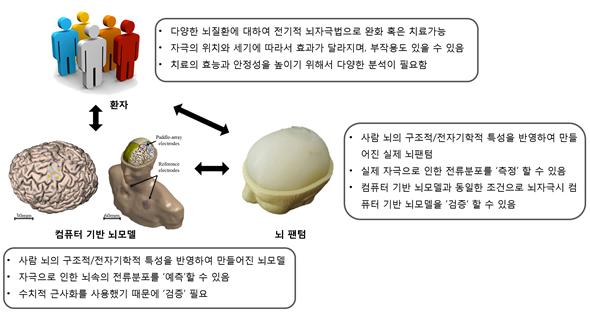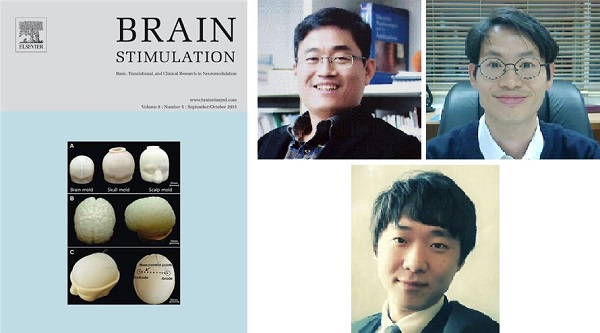Media Center
A multimedia mosaic of moments at GIST
GIST Excellence
[Press Release] GIST research team led by Dr. Sung Chan Jun and Dr. Euiheon Chung developed phantom heads to validate computational studies for electrical brain stimulation
- 엘리스 리
- REG_DATE : 2015.10.19
- HIT : 789
Phantom heads developed by Dr. Sung Chan Jun and Dr. Euiheon Chung
validate the accuracy of electrical brain stimulation
validate the accuracy of electrical brain stimulation

□ GIST (Gwangju Institute of Science and Technology) researchers have produced phantom* heads that can increase the effectiveness of electrical brain stimulation to treat neurological disorders by helping to verify the accuracy of computer-based modeling. The result is a 3d model of the human head that can help increase the reliability of computer-based modeling techniques to predict the brain stimulation pattern when using electrical brain stimulation to treat neurological disorders, such as Parkinson"s disease and depression.
* Phantom: a model of an organ that uses specific geometries and materials to replicate or simulate the functions of the actual organ in various laboratory experiments or procedures.
∘ GIST Professor Sung Chan Jun of the School of Information and Communications and Professor Euiheon Chung (co-corresponding author) from the Department of Medical Systems Engineering and the School of Mechatronics led the research conducted by Ph.D. candidate Donghyeon Kim of the School of Information and Communications. This research was supported by grants from the Institute of Medical System Engineering (iMSE) at GIST, the GIST-Caltech Research Collaboration Project, the Integrative Aging Research Center of GIST, and the National Research Foundation (NRF) of Korea, which is funded by the Ministry of Education, Science and Technology.
∘ The results of the research were published in Brain Stimulation, which is the world"s leading journal on brain stimulation, for the September-October issue as the front cover-story (volume 8, issue 5).
* Paper title: Validation of Computational Studies for Electrical Brain Stimulation With Phantom Head Experiments
□ Electrical stimulation of the brain may help treat or alleviate the symptoms of a variety of neurological disorders and may help improve the overall health of the brain, but electrical stimulation methods tailored to treat individual diseases in limited clinical applications have not yet been ascertained. Computational studies for electrical brain stimulations (EBS) are used to determine effective treatment methods; however, few studies have validated the results of those computational studies, particularly in regards to invasive cortical stimulation.
□ The researchers simulated the structural and electromagnetic properties of the human brain by creating phantom head models with a 3d printer. By using three phantom head models, EBS was used to compare the electric potential distributions generated by both numerical simulation and empirical measurements. Using this approach, the researchers were able to verify that both the electric potential distributions from the numerical simulations behaved similarly with the experimental results.

(Figure 1) Figure 1 shows the layered sub-mold construction of the phantom head models.
(E) shows the completely assembled phantom head model.
(E) shows the completely assembled phantom head model.
∘ The researchers used magnetic resonance imaging (MRI) to recreate the brain"s structure using a 3D printer. To replicate the electrical properties of the human brain, the models were made with three different kinds of agarose and sodium chloride (Agar/NaCl) mixtures to simulate as closely as possible the actual isotropic conductivities of the human. The electrical properties of the Agar/NaCl mixture are freely adjustable depending on the mixture"s ratio. After solidifying, it can be used within the phantom head framework to mimic different electrical properties.
∘ The researchers showed that the results of using EBS to compare electric potential distributions generated by both numerical simulations and end empirical measurements in three phantom head models were similar and resulted in an average relative difference of 5.4% for the spherical phantom and 10.3% for the MRI-based phantom.
∘ These results demonstrate that numerical simulation is reasonably consistent with actual experimental measurements and can be used in advance to predict a particular brain stimulation effect for a specific patient, which may create new effective strategies for individual treatment.

(Figure 3) The September to October cover of Brain Stimulation.
(Clockwise) Professor Sung Chan Jun, Professor Euiheon Chung, and Ph.D. candidate Donghyeon Kim.
□ GIST Professor Sung Chan Jun said, "Our research into using phantom head models is a fusion approach to research that verifies the reliability of computer-based modeling that will increase the accuracy of electrical stimulation for the brain. We believe that our findings will contribute to the development of effective new treatment methods for various neurological disorders, such as dementia or depression."